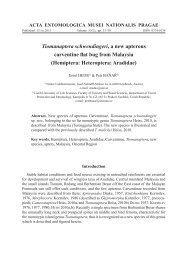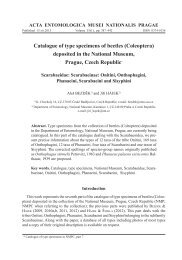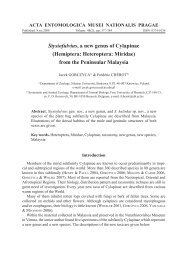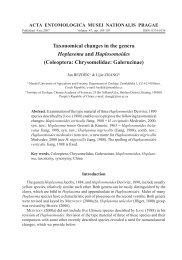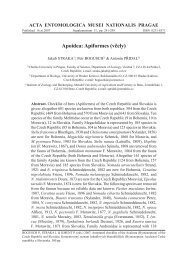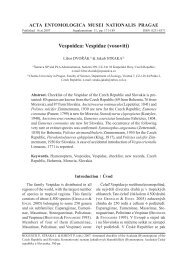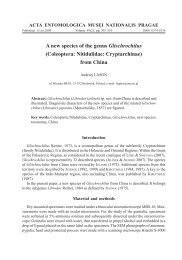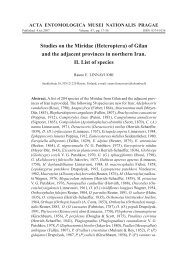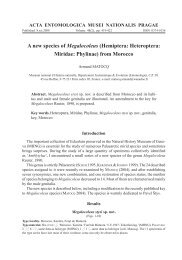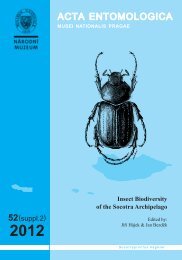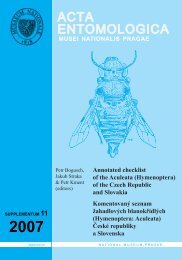Revision of the Palaearctic species of the Coccinella ...
Revision of the Palaearctic species of the Coccinella ...
Revision of the Palaearctic species of the Coccinella ...
Create successful ePaper yourself
Turn your PDF publications into a flip-book with our unique Google optimized e-Paper software.
Acta Entomologica Musei Nationalis Pragae, 45, 2005 131<br />
with it; ii) downgraded <strong>the</strong> monotypic genus Chelonitis Weise, 1879 to a subgenus <strong>of</strong> <strong>Coccinella</strong><br />
and carried out nomenclatural changes resulting from <strong>the</strong> thus arisen secondary homonymy<br />
<strong>of</strong> <strong>the</strong> nominotypical <strong>species</strong>; iii) proposed a separate subgenus, Acoccinella Iablok<strong>of</strong>f-<br />
Khnzorian, 1979, for <strong>the</strong> peculiar C. barovskii Iablok<strong>of</strong>f-Khnzorian, 1970; iv) classified <strong>the</strong><br />
remaining <strong>species</strong> as <strong>Coccinella</strong> s. str., which became an assemblage <strong>of</strong> <strong>species</strong> belonging to<br />
at least five <strong>species</strong> groups <strong>of</strong> <strong>Coccinella</strong> proposed by DOBRZHANSKIY (1931). Based on <strong>the</strong><br />
study <strong>of</strong> available type material, IABLOKOFF-KHNZORIAN (1979) catalogued 26 <strong>Palaearctic</strong> <strong>species</strong><br />
<strong>of</strong> <strong>Coccinella</strong> including three <strong>species</strong> he did not study, and confirmed and/or clarified <strong>the</strong><br />
nomenclature <strong>of</strong> most treated <strong>species</strong>. However, he could not evaluate those published by LIU<br />
(1962), his decision on <strong>species</strong> described by KAPUR (1963) remained obscure, he did not<br />
study <strong>the</strong> types <strong>of</strong> C. iranica Dobrzhanskiy, 1926, and he entirely missed C. marussii Kapur,<br />
1973. The subsequent monograph by IABLOKOFF-KHNZORIAN (1982) is principal for students <strong>of</strong><br />
<strong>the</strong> Palaeartic Coccinellinae. In that work he fully followed his previous taxonomic concept<br />
(including <strong>the</strong> imperfections mentioned above) (IABLOKOFF-KHNZORIAN 1979), shortly redescribed<br />
external characters as well as <strong>the</strong> genitalia <strong>of</strong> both sexes in most <strong>species</strong>, added two<br />
new ones, and provided two identification keys based on external characters and on genitalia;<br />
all <strong>species</strong> and some details are figured. His data on types and type depositories are valuable;<br />
geographic distribution, overall review <strong>of</strong> bionomy and extensive individual variation <strong>of</strong> some<br />
<strong>species</strong> remained ra<strong>the</strong>r scarcely taxonomically treated. In an equally important and valuable<br />
work, GORDON (1985) treated <strong>the</strong> Coccinellidae <strong>of</strong> North America north <strong>of</strong> Mexico. He adopted<br />
BROWN’s (1962) identification key <strong>of</strong> Nearctic <strong>Coccinella</strong>, did not support <strong>the</strong> subgeneric<br />
division <strong>of</strong> <strong>Coccinella</strong>, and did not include <strong>the</strong> Mexican sub<strong>species</strong> <strong>of</strong> C. transversoguttata.<br />
He supplemented short diagnoses <strong>of</strong> some <strong>species</strong> with excellent figures <strong>of</strong> habitus and genitalia,<br />
and gave valuable data on types and type depositories, and mapped distribution <strong>of</strong><br />
some <strong>species</strong>.<br />
The present paper contributes to <strong>the</strong> knowledge <strong>of</strong> <strong>the</strong> morphology and taxonomy <strong>of</strong> <strong>species</strong><br />
belonging to <strong>the</strong> C. transversoguttata <strong>species</strong> group proposed originally by DOBRZHAN-<br />
SKIY (1931) for two <strong>Palaearctic</strong> <strong>species</strong>.<br />
Material and methods<br />
The present paper is based predominantly on <strong>the</strong> collection <strong>of</strong> <strong>the</strong> Department <strong>of</strong> Entomology<br />
<strong>of</strong> <strong>the</strong> National Museum, Praha (NMPC). Fur<strong>the</strong>r material comes from <strong>the</strong> collections <strong>of</strong><br />
V. Navrátil, Praha, Czech Republic (CVNC) and M. Šlachta, České Budějovice, Czech Republic<br />
(CMSC). Standard methods <strong>of</strong> mounting and measurement were applied by means <strong>of</strong><br />
a stereoscopic and transmitted-light microscope with an ocular micrometer. Dissected body<br />
parts, abdomen and tarsal claw were mounted with a methylcelulose glue on <strong>the</strong> same card as<br />
<strong>the</strong> specimen; <strong>the</strong> antennae and genitalia are preserved in polyethylene microvials with glycerine<br />
attached to <strong>the</strong> same pin as <strong>the</strong> specimen. Means and <strong>the</strong>ir ratios were calculated from at<br />
least six measurements. Measurements are given in <strong>the</strong> following form: Mean (Minimummaximum).<br />
Basic scheme <strong>of</strong> colour pattern and <strong>the</strong> nomenclature <strong>of</strong> elytral spots follow DO-<br />
BRZHANSKIY (1931).



